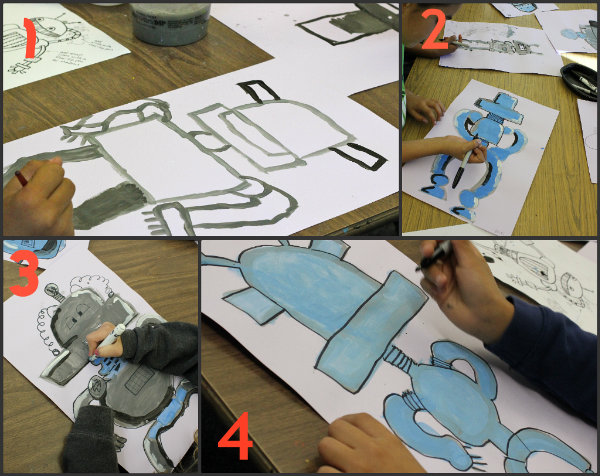
Robots are great fun to draw and until I saw this amazing robot lesson on John Post’s website, I never thought about painting robots. I love John’s hi-lighting and shading techniques that he incorporated into his lesson. For me, this was a perfect opportunity to teach my fourth grade students not only about shading but color value.
You’ll need a 12″ x 18″ sheet of light blue, green or purple paper, some black tempera paint and a small brush or a black waterproof pen, a tray of tempera paints (blue, black and white).
I resurrected an old handout that I have been using for a while now and encouraged the children to think about what elements a robot may have. We brainstormed lots of fun ideas and as the children called out things like rivets, wires, solar panels, I drew these things on the board.
- Then the kids got busy drawing their own robots with a small brush and black tempera paint (you could use a marker too).
- Once the drawing was completed (I emphasized large shapes), I set out a palette of tempera paints. For this lesson, I used blue, white and black tempera. I asked the students to create a grey for the main robot color, but they could mix in blue if they wanted.

3. To add hi-lights and shading, the children painted white along one side of the robot and black along the other.
4. Once the paint was dry, they outlined the robot with the Sharpie and added lots of small details. Some kids used colored pencils to color in details.
Aren’t they fabulous! Thanks John for the great lesson!

Related Links:













They are fabulous! I will have to do this with my classes next year. Thanks.
artteajannell.blogspot.com
I love these. Great illustration lesson and using tints and shades.
Patty,
I found John’s blog last year and was amazed at the level his 2nd graders were painting. I was a little taken aback at his art teaching manifesto which pretty much said that anyone who used TP rolls to make projects with wasn’t professional in his opinion. But I kept reading and found his ideas were thought provoking and interesting. I wish I had his knowledge about clay! I love your student’s take on the robots and will add this project to my “must do” list for next fall.
:)Pat
I’ll need to go back and read his manifesto!
Hi Patty, I used your robots lesson plan with G3/4 with wonderful results. Thanks. Need more of your ideas. Jan
Hi from Australia, great exercise for the older classes. You have inspired me to go forth with this project but with a couple of adaptions. If we succeed I will send you some photo’s 🙂
Great post! Any good children’s books to recommend with this project? I would use this for K-2 grades.
Is your handout available in one of the pdf’s in your shop?
Hi Karin,
No, it’s only available though my Teaching Art 101 e-course. Sorry!
John Post’s website is not able to be found. Do you have a new link you can put on your post for him?
Sorry Natasha. It’s hard to maintain external websites. What I would suggest is to google his name and see what pops up. Thank you for letting us know 🙂
Amazing!
Why is a 12×18 sheet of light blue, green or purple paper needed in this project? I don’t see where it is used.
I had the kids paint on both white paper and a colored paper. The colored paper offers a good base for the light paint, but it’s not necessary. You can us white paper. Try it and see what works for you. Have fun!
I tried to download it….said it couldn’t be found.